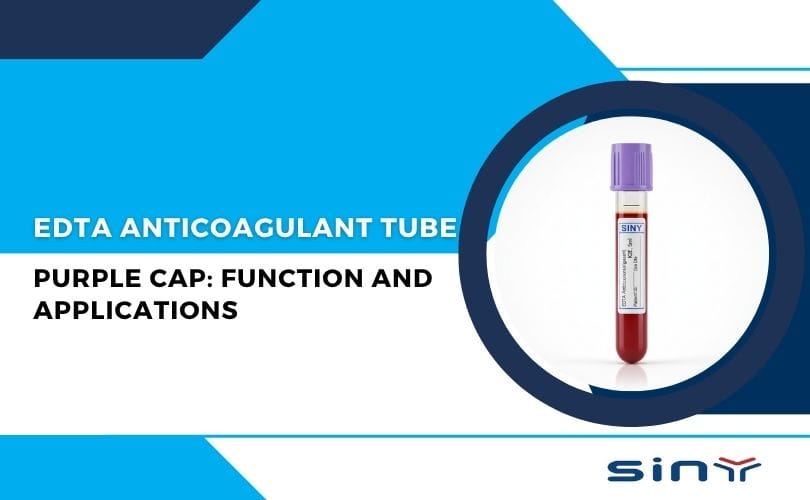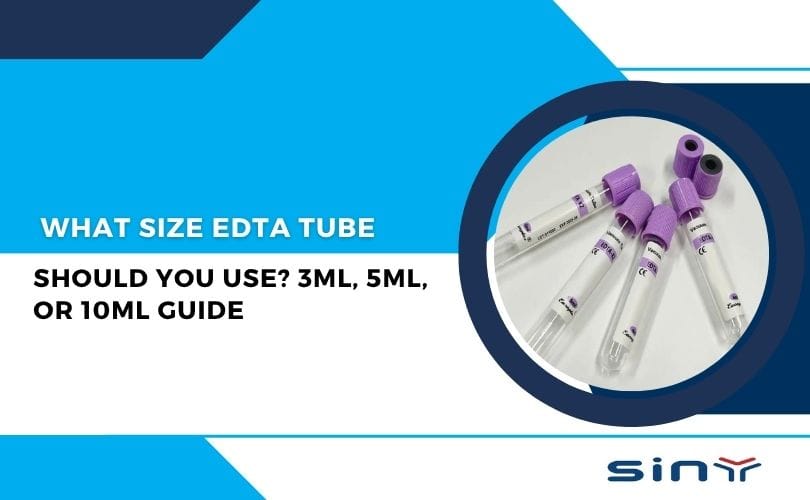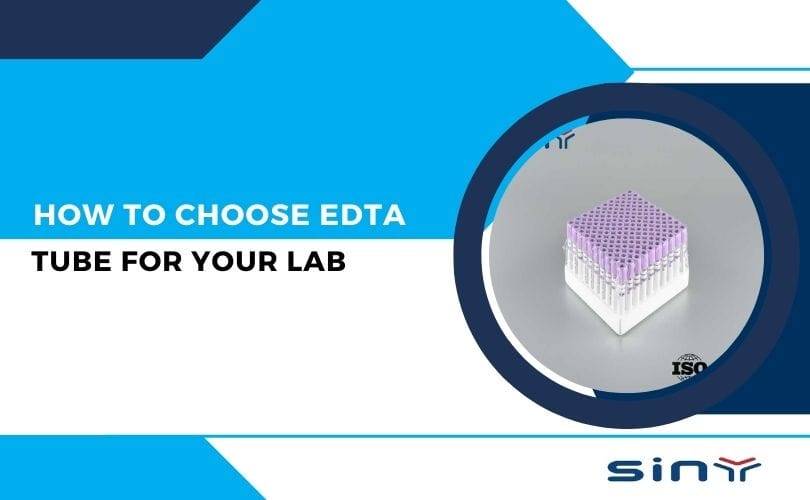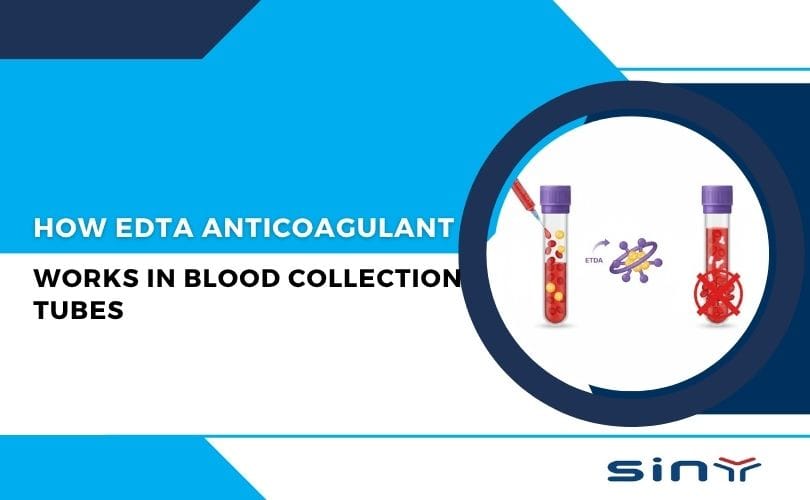The EDTA Anticoagulant Tube Purple Cap is one of the most commonly used blood collection tubes in laboratories worldwide. It contains EDTA, a chelating agent that binds calcium ions, effectively preventing blood clotting. This makes it an ideal choice for complete blood count (CBC), blood typing, and other hematological investigations.
You can find a wide range of these tubes at EDTATube.com, a leading provider specializing in high-quality EDTA blood collection tubes designed for accuracy and reliability in diagnostics.
The purple cap color is standardized, ensuring instant recognition for technicians who handle multiple samples daily.
What is an EDTA Anticoagulant Tube Purple Cap?
The EDTA Anticoagulant Tube Purple Cap is a specialized blood collection tube coated with Ethylenediaminetetraacetic Acid (EDTA), a potent anticoagulant. The purple cap distinguishes it from other tubes, indicating its use for hematology tests. EDTA prevents blood clotting by chelating calcium ions, which are essential for coagulation.
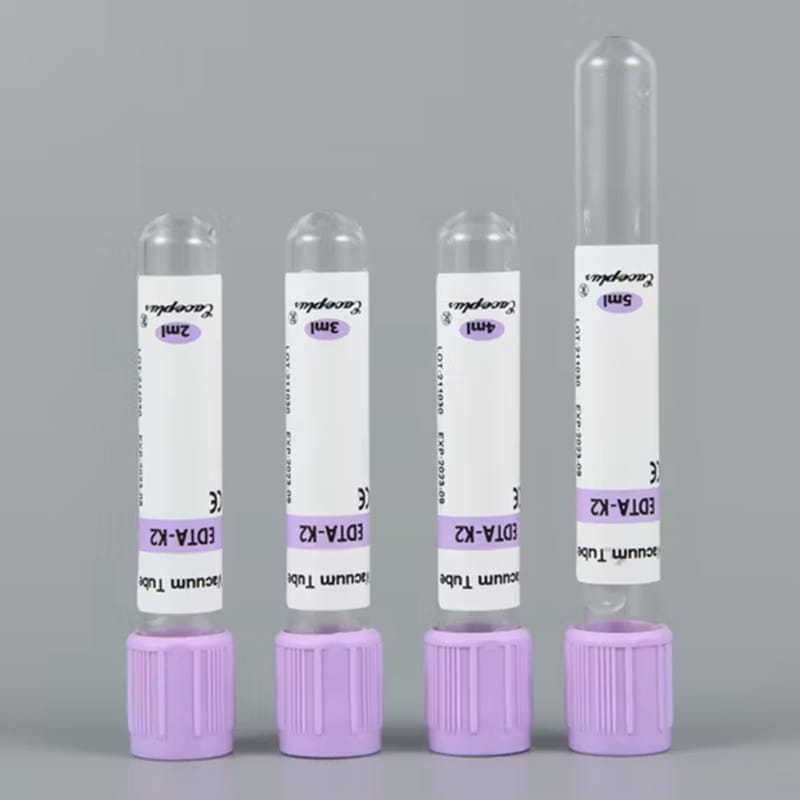
These tubes are widely used in clinical laboratories, research institutions, and diagnostic centers for tests such as complete blood count (CBC), blood smears, and molecular diagnostics. Their reliability and consistency make them indispensable in medical practices.
For more details on EDTA tubes, visit our product page: EDTA Tubes for Blood Collection.
Decoding the Core Principle: How EDTA Anticoagulant Works
To appreciate the significance of the EDTA Anticoagulant Tube Purple Cap, one must understand its chemical action. The anticoagulant mechanism is precise, powerful, and irreversible, hinging on the molecule’s unique structural properties. For a deeper understanding of what is the principle of EDTA anticoagulant, we will explore its structure and mechanism in detail.
The Chemical Structure of Ethylenediaminetetraacetic Acid (EDTA)
EDTA, or Ethylenediaminetetraacetic acid, is an aminopolycarboxylic acid. Its molecular structure features four carboxylic acid groups and two nitrogen atoms, all of which contain lone pairs of electrons. These six coordination sites allow the EDTA molecule to surround and tightly bind to a metal ion, creating a stable, ring-like structure. This process is known as chelation, and it is the entire basis of EDTA’s effectiveness.
The compound is typically used in the form of a salt (such as Dipotassium EDTA, or K2EDTA, or Tripotassium EDTA, or K3EDTA) to enhance its solubility and stability when coated inside the blood collection tube.
The Power of Chelation: Irreversible Calcium Binding
The primary target of EDTA in the blood is the calcium ion ($Ca^{2+}$).
The blood coagulation cascade is a complex, multi-step process involving numerous clotting factors (proteins), many of which rely on calcium as an essential cofactor or “spark” to become activated. Without free, ionized calcium, the entire enzymatic cascade comes to a screeching halt.
When blood enters the EDTA Anticoagulant Tube Purple Cap, the EDTA instantly and aggressively binds to the available calcium ions. It forms a stable, water-soluble complex that sequesters the calcium, effectively removing it from the plasma and making it chemically unavailable to the clotting factors. This action achieves instantaneous and irreversible anticoagulation. This precise mechanism perfectly demonstrates how EDTA anticoagulant works in blood collection tubes.
Why Calcium is Critical for the Coagulation Cascade
To fully grasp the mechanism, a brief review of the coagulation pathway is helpful. The clotting cascade proceeds through intrinsic, extrinsic, and common pathways, culminating in the formation of a stable fibrin clot.
Calcium ($Ca^{2+}$) is critical in several key steps, including:
- Activation of Factor X: Calcium is necessary for the activation of Factor X (converting it to Xa), a central component of the common pathway.
- Activation of Prothrombin: Calcium, along with phospholipids, is required to convert prothrombin (Factor II) into its active form, thrombin (Factor IIa).
- Fibrin Formation: Thrombin, once activated, converts soluble fibrinogen into insoluble fibrin strands, which form the meshwork of the clot.
By removing the $Ca^{2+}$ cofactors, EDTA prevents the activation of Factor X and thrombin, thereby eliminating the possibility of fibrin formation and successfully preserving the sample as whole blood.
Variations of the EDTA Purple Cap: K2EDTA vs. K3EDTA and Their Clinical Differences
While the term EDTA Anticoagulant Tube Purple Cap refers broadly to all tubes containing this additive, there are two primary formulations used in clinical practice: K2EDTA (Dipotassium) and K3EDTA (Tripotassium). These slight chemical variations have specific implications for sample quality and testing accuracy.
| Feature | K2EDTA (Dipotassium) | K3EDTA (Tripotassium) |
| Form in Tube | Spray-dried liquid or powder (most common). | Liquid solution or powder. |
| Effect on Dilution | Minimal to no dilution effect. | Causes slight dilution (approx. 1-2%) due to liquid volume. |
| Effect on Cell Volume (MCV) | Minimal effect. | May cause slight red blood cell shrinkage (decrease in Mean Corpuscular Volume, or MCV) due to osmotic effects. |
| Industry Recommendation | Recommended by the International Council for Standardization in Haematology (ICSH) for hematology testing. | Less preferred by ICSH due to potential for slight dilution/shrinkage. |
| Clinical Advantage | Preferred for automated cell counters and DNA analysis, providing the most accurate cell size readings. | Historically used, still common, but requires careful calibration on automated analyzers. |
The choice between K2EDTA and K3EDTA, while seemingly minor, can impact certain blood parameters, which is why standardization and quality manufacturing are paramount. Reputable suppliers ensure their EDTA tubes for blood collection meet the highest performance standards, often favoring K2EDTA for general hematology. Commercial partners can explore product options and manufacturing quality through trusted channels like Siny Medical’s EDTA tube guide or directly from Siny Medical.
Comprehensive Applications: Where the EDTA Tube Reigns Supreme
The ability of the EDTA Anticoagulant Tube Purple Cap to preserve whole blood and maintain cellular integrity makes it the anticoagulant of choice for a wide spectrum of diagnostic tests. The reliability of the EDTA blood anticoagulant in blood collection tube is unmatched for cellular analysis.
Routine Hematology: The Complete Blood Count (CBC)
The Complete Blood Count (CBC) is the single most common test performed using the EDTA tube. The CBC provides a quantitative and qualitative assessment of the three major cell lines in the blood:
- Red Blood Cells (RBCs): The CBC measures the RBC count, Hemoglobin (Hb), Hematocrit (Hct), and indices like MCV and Mean Corpuscular Hemoglobin Concentration (MCHC). EDTA ensures the cells do not swell or shrink excessively, which is crucial for accurate volume measurements (MCV) necessary to diagnose different types of anemia.
- White Blood Cells (WBCs): It measures the total WBC count and the differential count (identifying and counting the five main types of leukocytes: neutrophils, lymphocytes, monocytes, eosinophils, and basophils). EDTA prevents the clumping and destruction of these delicate cells, providing a true representation of the body’s immune status.
- Platelets (PLT): The count and Mean Platelet Volume (MPV) are assessed. Proper mixing in the EDTA tube is essential to prevent platelet clumping, which could otherwise lead to a falsely low platelet count (pseudothrombocytopenia).
Transfusion Medicine: Blood Typing and Cross-matching
In transfusion services, the EDTA tube (sometimes a specific pink-top tube, which also contains EDTA) is the standard for:
- ABO and Rh Typing: Determining the patient’s major blood group (A, B, AB, O) and Rh status. EDTA maintains the integrity of the red blood cell membrane, ensuring that the antigens used for typing tests remain intact and reactive.
- Antibody Screening and Identification: Detecting unexpected antibodies in the patient’s plasma that could react with donor blood.
- Cross-matching: The final compatibility test between patient serum/plasma and donor red blood cells.
Molecular Diagnostics and Genetics
The function of EDTA extends far beyond cellular analysis. Its powerful chelating properties make it an excellent stabilizer for genetic material:
- DNA/RNA Preservation: EDTA is used to inhibit the activity of metal-dependent enzymes, particularly nucleases, which are enzymes that degrade DNA and RNA. By chelating the magnesium ions ($Mg^{2+}$) that these nucleases require as cofactors, EDTA effectively halts enzymatic degradation. This preservation is crucial for subsequent genetic analysis techniques, such as Polymerase Chain Reaction (PCR), sequencing, and genomic studies.
- Buffy Coat Isolation: After centrifugation of EDTA whole blood, the buffy coat (the layer containing WBCs and platelets) is a primary source for genomic DNA and RNA extraction.
Monitoring Chronic Conditions: Hemoglobin A1c (HbA1c)
The EDTA tube is the universally accepted container for the Hemoglobin A1c (HbA1c) test, which is used to monitor long-term glucose control in diabetic patients. The test measures the percentage of hemoglobin molecules that have glucose bound to them (glycated hemoglobin). Since the EDTA tube preserves the red blood cells, it ensures an accurate and stable measurement of HbA1c, reflecting the average blood sugar level over the preceding two to three months.
Mastering Phlebotomy: Best Practices for Using EDTA Tubes
The integrity of a blood sample collected in the EDTA Anticoagulant Tube Purple Cap depends entirely on proper phlebotomy technique. Even the highest-quality tube can fail if handling errors are made.
The Critical Importance of Fill Volume and Ratio
The concentration of EDTA in the tube is precisely calibrated to the volume of blood the tube is designed to draw (the draw volume). This ensures an optimal blood-to-anticoagulant ratio, typically around 1:200.
- Underfilling (Short Draw): If the tube is significantly underfilled, the concentration of EDTA relative to the blood volume will be too high. The excess EDTA can cause red blood cell shrinkage (leading to artificially low MCV and Hct values) and may even affect white blood cell morphology.
- Overfilling: While less common in vacuum tubes, overfilling dilutes the anticoagulant, allowing micro-clots to form, which can consume platelets and lead to a falsely low platelet count.
Adhering to the designated fill line is a non-negotiable step to ensure the accuracy of all subsequent test results.
The Gentle Mixing Technique: Inversion to Prevent Microclots
Improper mixing is one of the most common pre-analytical errors associated with EDTA tubes.
As soon as the blood is drawn, the blood near the additive is instantly anticoagulated, but the blood still flowing into the tube is not. Therefore, mixing is critical to distribute the EDTA throughout the entire sample. The correct procedure is as follows:
- Remove the tube from the holder.
- Gently invert the tube completely 8 to 10 times. An inversion involves turning the tube 180 degrees and back.
- Do NOT shake vigorously. Shaking causes shear stress on the red blood cells, leading to hemolysis (rupture of the cells), which releases intracellular contents (like potassium) into the plasma and contaminates the sample, making it unsuitable for many tests.
- Check for Clots: After mixing, the phlebotomist should inspect the tube to ensure no small clots have formed.
Adhering to the Standard Order of Draw
When collecting multiple blood samples, the Order of Draw sequence must be followed to prevent cross-contamination of additives, as some additives (especially EDTA) can carry over and interfere with the tests in the next tube. The standard sequence places the EDTA tube late in the draw order:
- Blood Culture Bottles (Sterile specimens)
- Coagulation Tubes (Light Blue Top – Citrate)
- Serum Tubes (Red, Gold, or Tiger Top – Clot Activator/Gel)
- EDTA Tubes (Purple/Lavender Top)
- Other Anticoagulants (e.g., Gray Top – Fluoride/Oxalate)
By adhering to this sequence, phlebotomists prevent EDTA from being carried over into a coagulation tube, where it would immediately chelate the calcium and invalidate the coagulation test.
EDTA Anticoagulant vs. Its Competitors: Heparin and Citrate
While EDTA is the gold standard for hematology, it is crucial to understand the limitations and appropriate uses of other common anticoagulants. A comparative analysis of EDTA vs other anticoagulants highlights why a lab must use the correct tube color for each specific test.
Mechanism Comparison Table
| Anticoagulant (Cap Color) | Primary Mechanism | Primary Test Application | Clinical Limitation |
| EDTA (Purple/Lavender) | Chelates (binds to) Calcium ions ($Ca^{2+}$). | Hematology (CBC, Blood Typing, HbA1c, DNA/RNA). | Cannot be used for calcium, iron, or coagulation tests. |
| Sodium Citrate (Light Blue) | Chelates Calcium, but reversibly. | Coagulation Assays (PT, aPTT, Fibrinogen). | Not suitable for hematology (dilutes sample) or chemistry. |
| Heparin (Green) | Inhibits Thrombin and other clotting factors via Antithrombin III. | Plasma Chemistry, Stat Tests, Chromosome Analysis. | Interferes with blood smears (background staining) and is unsuitable for hematology. |
Clinical Scenarios Where EDTA is Unsuitable
Despite its effectiveness, the EDTA Anticoagulant Tube Purple Cap cannot be used for every test:
- Coagulation Tests: Because EDTA permanently removes the calcium required for clotting, it cannot be used for Prothrombin Time (PT) or Activated Partial Thromboplastin Time (aPTT) tests. These require a sodium citrate (light blue cap) tube, which reversibly binds calcium, allowing it to be added back during the assay to initiate clotting under controlled conditions. This difference is key when considering an EDTA separation gel coagulation blood collection tube.
- Chemistry Panels: EDTA interferes with many enzyme assays in clinical chemistry because those enzymes require metal ions (like $Ca^{2+}$ or $Mg^{2+}$) as cofactors. Additionally, EDTA is a potassium salt, so it drastically increases plasma potassium levels, rendering it useless for potassium and electrolyte measurement. Green top (Heparin) tubes are generally used for most plasma chemistry tests.
- Trace Element/Heavy Metal Testing: EDTA is a chelator, which means it can interfere with or contaminate samples intended for trace element analysis (e.g., zinc, copper). These often require Royal Blue cap tubes specifically certified to be trace-element free.
The Importance of Quality Manufacturing in Blood Collection
The reliability of a laboratory test begins with the quality of the primary collection device: the tube itself. The performance of the EDTA Anticoagulant Tube Purple Cap depends on exact manufacturing processes. Manufacturers must strictly control:
- Additives Dosage: The precise weight or volume of K2EDTA or K3EDTA must be consistent to ensure the correct blood-to-anticoagulant ratio, preventing the osmotic effects of over- or under-concentration.
- Vacuum Accuracy: The depth of the vacuum seal determines the precise blood volume collected. A consistent vacuum ensures that the blood fills to the designated line.
- Sterility and Materials: The tube must be sterile, and the materials (usually PET plastic) must be of medical grade, ensuring there is no interaction with the blood sample that could cause contamination or hemolysis.
For commercial buyers prioritizing high quality and global standards, partnering with companies that demonstrate commitment to excellence is essential. You can learn more about us and our dedication to quality assurance at edtatube.com.
We also encourage buyers to explore reputable manufacturers like those associated with the Siny Medical’s YouTube channel for insights into production and quality control. Reliable supply chains are essential for consistent patient care. In this regard, the manufacturing capabilities of companies like Siny Medical are often showcased on global B2B platforms.
Potential Pitfalls and Pre-Analytical Errors with EDTA Tubes
While the EDTA Anticoagulant Tube Purple Cap is highly effective, it is not immune to pre-analytical errors, which can lead to misdiagnosis. Awareness and strict adherence to protocol are the first line of defense.
Pseudothrombocytopenia (EDTA-Dependent Platelet Clumping)
This is a well-documented artifact where the patient’s platelets aggregate (clump) when exposed to EDTA. This clumping causes the automated hematology analyzer to register a falsely low platelet count (thrombocytopenia). Since the patient’s actual platelet count is normal, this is termed pseudothrombocytopenia. This error requires follow-up collection in a different anticoagulant (usually Sodium Citrate or Heparin) to verify the true count. This phenomenon highlights the sensitivity of blood components to chemical interaction.
Osmotic Effects (Cell Shrinkage)
As previously discussed, excessive EDTA concentration (usually due to a short draw, especially with K3EDTA) can cause an osmotic imbalance, drawing water out of the red blood cells. This results in:
- Decreased Mean Corpuscular Volume (MCV): Cells appear smaller than they are.
- Decreased Hematocrit (Hct): The percentage of red blood cells in the total blood volume appears artificially low.
Inaccurate Coagulation and Chemistry Results
The most serious errors arise when the wrong tube is used for the test. Using an EDTA Anticoagulant Tube Purple Cap for a test that requires calcium (like PT/aPTT) or for a chemistry test (like potassium or calcium measurement) will result in a rejected sample or a critically inaccurate result, leading to potential patient harm. Adherence to the Order of Draw and careful visual inspection of the tube cap color before drawing are mandatory safety checks.
Conclusion
The EDTA Anticoagulant Tube Purple Cap is arguably the most vital tool in the modern hematology laboratory. Its simple yet powerful mechanism—the chelation of calcium ions—ensures that whole blood remains in its native, fluid state, making accurate cell counting, analysis, and blood typing possible. From diagnosing life-threatening cancers and infectious diseases to managing diabetes and ensuring safe blood transfusions, the reliability of this purple tube is foundational to clinical care.
For laboratories and healthcare facilities, the choice of supplier is an extension of their commitment to quality. Investing in high-quality, ISO-certified EDTA Anticoagulant Tube Purple Cap products is essential for minimizing pre-analytical errors and guaranteeing the accuracy of patient diagnostics. For reliable products and partnership opportunities, you can contact us directly at the official website.
FAQs
Q1: Why is the EDTA tube cap colored purple (or lavender)?
The color coding of blood collection tube caps is standardized by the Clinical and Laboratory Standards Institute (CLSI) to ensure immediate and universal identification of the additive inside. The purple or lavender cap signifies the presence of Ethylenediaminetetraacetic acid (EDTA), which is the preferred anticoagulant for hematology tests. This standardization prevents errors, ensuring the correct sample is used for the correct test.
Q2: What are the main tests performed using the EDTA purple cap tube?
The EDTA Anticoagulant Tube Purple Cap is primarily used for tests that require whole blood analysis and cellular preservation. These include:
- Complete Blood Count (CBC) and Differential
- Hemoglobin A1c (HbA1c)
- Blood Typing (ABO/Rh) and Cross-matching
- Erythrocyte Sedimentation Rate (ESR)
- Reticulocyte Counts
- Molecular/Genetic Testing (DNA/RNA extraction)
Q3: How quickly must the EDTA tube be mixed after collection?
The EDTA tube must be mixed immediately after collection, as soon as it is removed from the needle holder. You should gently invert the tube 8 to 10 times. Delaying mixing or failing to mix adequately will lead to the formation of micro-clots, which will render the sample unsuitable for CBC testing, often resulting in a false low platelet count (pseudothrombocytopenia).
Q4: Can an EDTA tube be used for chemistry tests, such as measuring electrolytes?
No, the EDTA tube should not be used for most chemistry tests, especially those measuring electrolytes (like potassium) or calcium. The EDTA additive is a potassium salt, which will artificially and drastically increase the measured plasma potassium level. Furthermore, EDTA chelates (removes) calcium, which is required for many chemistry enzyme reactions, causing inaccurate results. The standard tube for basic chemistry is usually the Green Cap (Heparin) tube or the Serum Separator Tube (SST – Gold or Tiger Top).
Q5: What is the difference between K2EDTA and K3EDTA?
Both K2EDTA (Dipotassium) and K3EDTA (Tripotassium) are forms of the EDTA salt used as anticoagulants. The key difference lies in their impact on the blood sample volume:
- K2EDTA is usually spray-dried and has minimal dilutional effect, making it the form recommended by the ICSH for hematology.
- K3EDTA is often a liquid additive, which can cause a slight (1-2%) dilution of the sample and may lead to a minor decrease in the measured MCV and Hct values due to osmotic differences.
Q6: Can I use an EDTA tube for blood cultures?
No. Blood culture bottles must be drawn first in the Order of Draw to maintain sterility, as they are used to detect microbial contamination. EDTA tubes contain additives that could contaminate the culture sample.
Q7: Why is the proper fill volume so important for the EDTA tube?
The proper fill volume ensures the blood maintains the correct blood-to-anticoagulant ratio.
- Underfilled tubes have an excess amount of EDTA, causing red blood cell shrinkage and low volume readings (low MCV/Hct).
- Overfilled tubes have too little EDTA, risking clot formation and inaccurate cell counts (e.g., falsely low platelets).
Q8: Where can I find high-quality EDTA blood collection tubes?
For reliable, medically certified EDTA tubes for blood collection, it is recommended to source from manufacturers and suppliers who adhere to ISO and CLSI standards. You can explore high-quality options and technical specifications directly on the supplier’s website, such as edtatube.com.

